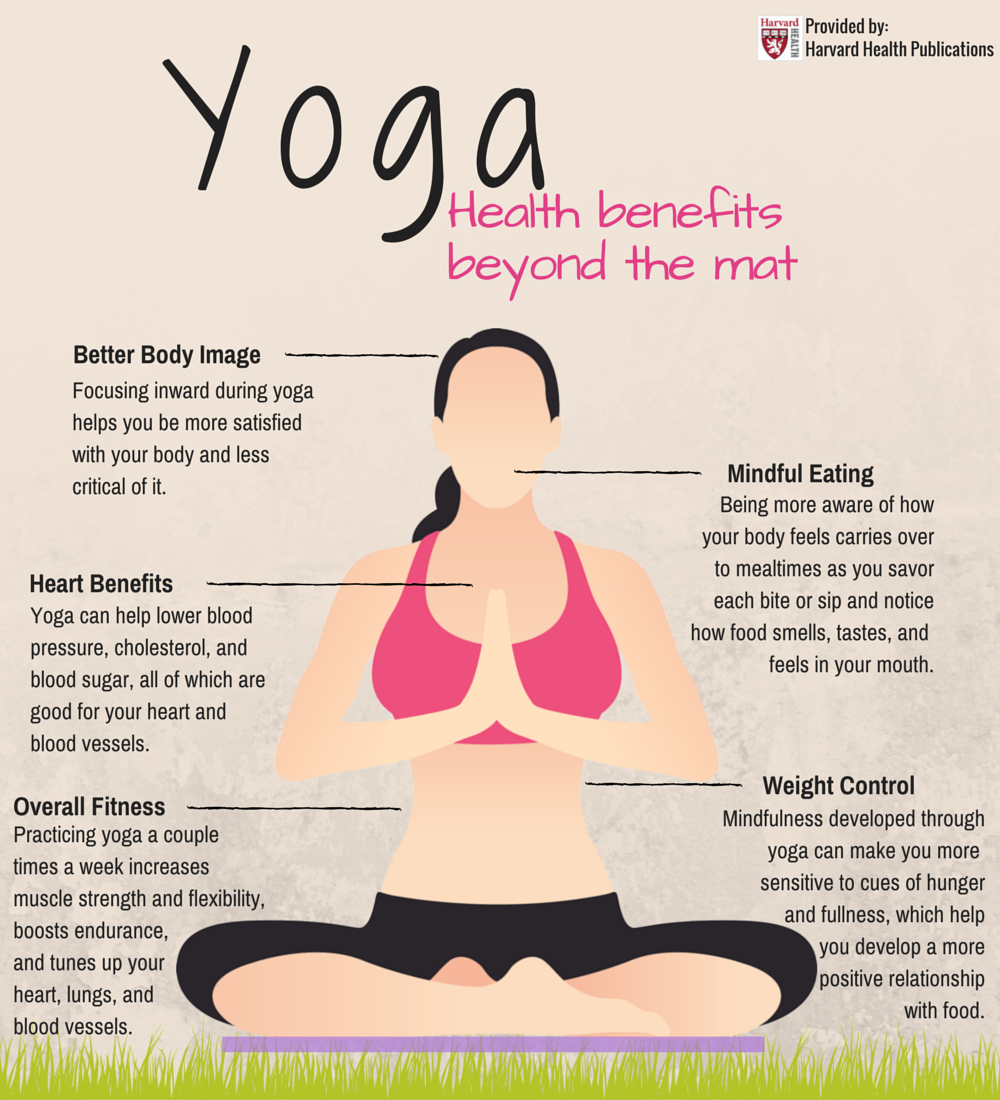
If you're looking for a way to reduce stress, yoga could be the answer. Regular yoga practice can lead to a more relaxed state of mind. It can regulate the production and release of melatonin which is responsible for the regulation of sleep cycles and inner peace. Yoga has been shown to reduce stress and increase melatonin production in numerous studies.
The important stress-reliever is the seated forward fold. It reduces anxiety, tension headaches, as well as insomnia. It is a restorative pose that should be held for at least five minutes. This is a great way of relaxing before bed. It also stretches the legs, lower back and torso. It also relieves sore, achy feet. It is a great way for calm before going to bed.

Yoga can help manage stress. By strengthening the right insula and decreasing the activation of the amygalda, it can help you reduce your stress. If your body is aware that it is being overloaded with negative stimuli, it can relax more easily. The benefits of yogic meditation include a decreased risk of a fight or flight response to stressful situations. Yoga can be a useful tool for managing your daily life.
Yoga can help you relax and improve your mental focus. Meditation can help reduce stress and boost GABA levels. GABA, the main brain chemical responsible in anxiety, is believed to be a key ingredient. Yoga can help you feel calmer in the long term. Yoga can also help with anxiety. This practice is quite effective. Let's see if you are ready to give this a go!
For those who want to calm their nervous system and reduce stress, yoga can be a great option. It is possible to calm your nervous system and relax by practicing specific poses on a daily basis. Begin restorative Yoga with savasana. A simple pose that requires a forward bend, savasana is the first. Try this pose by bringing your hands and arms close to the floor, closing your eyes and closing your eyes.

The Child's Pose is a great pose to do yoga in to reduce stress. It's a great stretch to your hips, thighs and ankles. It can also reduce stress. For a few seconds, you'll be more relaxed if you do the child's poses. You'll feel even better after you have practiced mountain pose. You're not the only benefit to yoga.
FAQ
Does being cold give you a weak immune system?
It has been said that there are two types of people on the planet: those who love winter, and those who don't. It doesn't really matter whether you love winter or loathe it. You might be wondering why it makes you miserable.
Our bodies were designed to work best in warm climates. Because of this, our bodies evolved to thrive and survive in hot climates.
Now, however, we live in a completely different environment to how our ancestors lived. We spend more time indoors, are exposed to extreme temperatures (cold/heat), and eat processed food rather than fresh.
This means that our bodies aren’t used to these extremes. It means that when we do go outdoors, we are often tired, sluggish or even sick.
These effects can be reversed, however. You can combat these effects by making sure you are well-hydrated all day. If you drink plenty of water, you'll help keep your body properly hydrated and flush toxins from your system.
It is important to eat healthy foods. Healthy food will help your body maintain its optimal temperature. This is especially helpful for people who spend a lot of time indoors.
Finally, consider taking a few minutes each morning to meditate. Meditation helps to calm your mind and body which can make it easier to deal stress and illness.
What's the difference of a calorie versus a Kilocalorie?
Calories can be used to measure how much energy is in food. Calories are a unit of measurement. One calorie equals one degree Celsius of energy to raise water temperature by 1 gram.
Kilocalories refer to calories in another term. Kilocalories can be measured in thousandsths of one calorie. 1000 calories is one kilocalorie.
Which lifestyle is best for your health?
Healthy lifestyles include eating healthy food, regular exercise, good sleep, and avoiding stress. If you follow these guidelines, you will be able to lead a long and healthy life.
It's easy to start small with your exercise and diet. To lose weight, you can start walking for 30 mins each day. If you're looking for a way to increase your activity, consider taking up swimming or dancing. You can also sign up for an online fitness program, such as Strava and Fitbit. This will track your activity.
How can I reduce my blood pressure
Find out the causes of high blood pressure first. Next, you will need to determine what is causing high blood pressure. You can do this by eating less salt, losing weight, or taking medication.
Also, make sure to get enough exercise. If you don’t have enough time to exercise regularly, consider walking more often.
You should join a gym if you are unhappy with your exercise routine. You'll probably want to join a gym where there are other people who share your goals. It's easier to stick to an exercise routine when you know someone else is going to see you at the gym.
Improve immunity with herbs and supplements?
Natural remedies and herbs can be used to increase immune function. Examples include ginger, garlic and oregano oils, echinacea, vitamin C, ginkgo loba, and echinacea.
These herbal remedies should not be used in place of conventional medical treatment. These herbal remedies can cause nausea, vomiting, stomach cramps or dizziness.
Statistics
- WHO recommends consuming less than 5% of total energy intake for additional health benefits. (who.int)
- The Dietary Guidelines for Americans recommend keeping added sugar intake below 10% of your daily calorie intake, while the World Health Organization recommends slashing added sugars to 5% or less of your daily calories for optimal health (59Trusted (healthline.com)
- WHO recommends reducing saturated fats to less than 10% of total energy intake; reducing trans-fats to less than 1% of total energy intake; and replacing both saturated fats and trans-fats to unsaturated fats. (who.int)
- According to the 2020 Dietary Guidelines for Americans, a balanced diet high in fruits and vegetables, lean protein, low-fat dairy and whole grains is needed for optimal energy. (mayoclinichealthsystem.org)
External Links
How To
What does "vitamin" actually mean?
Vitamins are organic compounds found naturally in food. Vitamins help us absorb nutrients from foods we eat. Vitamins cannot be produced by the body. They must be acquired from food.
There are two types of vitamins: water soluble and fat soluble. Water-soluble vitamins dissolve quickly in water. These include vitamin C (thiamine), Vitamin B1 (riboflavin), Vitamin B2 (riboflavin), Vitamin B3 (niacin), Vitamin B6 (pyridoxine), Vitamin C, B1 (thiamine), Vitamin B2 (riboflavin), Vitamin B3 (niacin), and Vitamin B6 (pyridoxine). Fat soluble vitamins are stored in the liver and fatty tissue. You can find vitamin D, E K, A, beta carotene, and other fat-soluble vitamins.
Vitamins are classified according their biological activity. There are eight major types of vitamins:
-
A – Essential for normal growth, and the maintenance of good health.
-
C - essential for nerve function and energy generation.
-
D - Vital for healthy bones and teeth
-
E is required for good vision and reproduction.
-
K - Essential for healthy muscles and nerves.
-
P - Vital for strong bones and teeth.
-
Q – aids digestion of iron and iron absorption
-
R - necessary for making red blood cells.
The recommended daily allowance of vitamins (RDA), varies according to age, gender, physical condition, and other factors. The U.S. Food and Drug Administration (FDA) sets the RDA values.
For adults over 19 years, the RDA is 400 mg per day for vitamin A. However, pregnant women need 600 micrograms per day because it is important for fetal development. Children ages 1-8 require 900 micrograms per day. Children under 1 year old require 700 micrograms daily, while infants over one year old need 500 micrograms every day. This decreases between 9 and 12 months.
Children aged 1-18 years need 800 micrograms daily, while children overweight require 1000 micrograms per days. Children who are severely obese or underweight will need 1200 micrograms each day.
Children aged 4-8 years old who have been diagnosed as having anemia require 2200 micrograms of vitamin C per day.
2000 micrograms is the minimum daily intake for adults over 50 years old to maintain good health. Breastfeeding or pregnant women require 3000 micrograms per daily due to higher nutrient demands.
1500 micrograms are required daily by adults over 70 because they lose approximately 10% of their muscle each decade.
Women who are pregnant and lactating need more nutrients than the RDA. Pregnant woman need 4000 micrograms daily in pregnancy, and 2500 per day after childbirth. Breastfeeding mothers need 5000 mg per day when breastmilk is being produced.